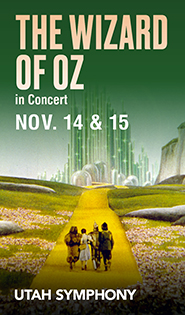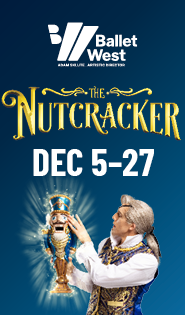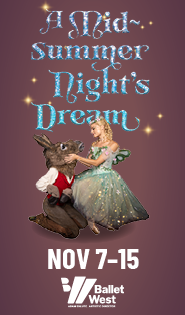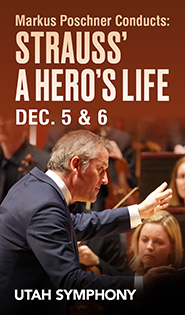No “I” in company: Ballet West ensemble shines in pairing of Robbins and Fonte
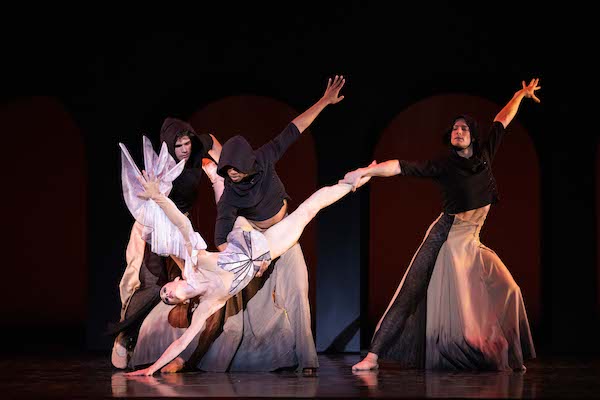
Ballet West is celebrating the expressiveness and versatility of its individual dancers this month with two contemporary works: Jerome Robbins’ original choreography for Philip Glass’ Glass Pieces; and Nicolo Fonte’s setting of Carl Orff’s Carmina Burana, which had its world premiere with this company in 2017.
In Friday night’s opening performance at the Capitol Theatre, both pieces contained worthwhile feature moments, particularly from exiting company stars Beckanne Sisk and Chase O’Connell. But this program’s strength centered in highlighting the power of the whole ensemble.
Glass Pieces rides heavily on the innate characteristics of Glass’ music — buoyant arpeggios, mathematical repetition and melodic fluidity. This balance between elegance and rigidity found its best expression on Friday in the work’s opening movement: a handful of micro-ensembles weaving between impromptu duos with an air of urban bustle and mechanized disorder reminiscent of Jacques Tati’s 1967 film, Playtime. Alongside the art-deco stage colorings and stark, graph-paper setting, this movement made the best case for Glass Pieces as optimistic, if fragile, ballet for the brave new world, the dancers moving about in jerks and saunters that evoked an automotive factory’s churn.
That dazzling rapturousness appeared only in glimpses in the less exciting follow-up movements. Movement two provided the technical peak of the entire evening, a silhouetted hieroglyphic march, but then faded into a duet dance that leaned too heavily on fluidity and wallowed inside Glass’ angular scoring. The third movement brought back the more animated ensemble for a war drum-influenced mating ritual, an enlivening finale that still didn’t reach the ecstatic heights of the piece’s opening.
The organized chaos honed so tightly in the first movement of Glass Pieces found greater consistency in the stunning spectacle of Carmina Burana. Here, the pull between composure and recklessness was explosive, with Fonte creating an exaggerated portrayal of battles between love and pain, life and death, fate and will. Fonte’s choreography mines Orff’s epic cantata for all its worth, tackling the humor, irony, sentimentality and fear in its already unique textual-musical relationship. It began with a flurry of limbs wavering and slithering like souls of the damned, the pitiful fatalism of “O Fortuna” gleefully soundtracking the horror.
The choreography’s focus on the angularity and flexibility of its dancers gave many scenes a chilling, uncanny-valley sense of stillness: The dancers frequently froze into unlikely contortions, balancing between and against one another. The best of these miniature tableau vivants appeared in Orff’s grim lament about aging, “Olim lacus colueram.” Principal artist Sisk played the role of the metaphorical swan, cascading between four other dancers as if pushed by gravity. Tenor soloist Christopher Puckett stood to the side with a watchful eye, observing without interfering.
The staging of the three soloists — Puckett, soprano Melissa Heath and baritone Christopher Clayton — gave a disquieting fourth-wall feel to the bare-bones Brecthian staging, with the choir in the risers and lighting scaffolds moving in and out of view. As the dancers played out these poetic fables, the soloists stood unaffected and often uninvolved, totems to the audience’s own state of spectacle.
In between the ballet’s chilling freeze-frame moments, the choreography focused heavily on direct action: people being thrown, caught, dropped, dragged and held. In the ensemble-heavy numbers “Ecce gratum” and “Chramer, gip die varwe mir,” bodies dipped in and ricocheted out like sock puppets and bouncing balls. “In trutina,” a poetic ode to forbidden desire, provided the work’s most enlivening collaboration: a romantic duet between dancers David Huffmire and Joshua Shutkind. Mirroring each other’s movements and occasionally — briefly, hesitantly — embracing and caressing, the pair delivered a heart-wrenching display of near-connection.
When the ballet looped back to the doom and gloom of “O Fortuna,” moments like the “In trutina” lingered, transmuting the heavy-metal fireworks of the opening frame into a more sober contemplation of fate and misery. The final pose had the cast arrange itself into a jigsaw straddle of interweaving parts — an almost shocking image that endured long after the curtain drop. Glass Pieces and Carmina Burana shone brightest in these moments, where the ensemble felt attuned to itself as a single, complicated being.
The Ballet West program runs thrugh April 9. balletwest.org

